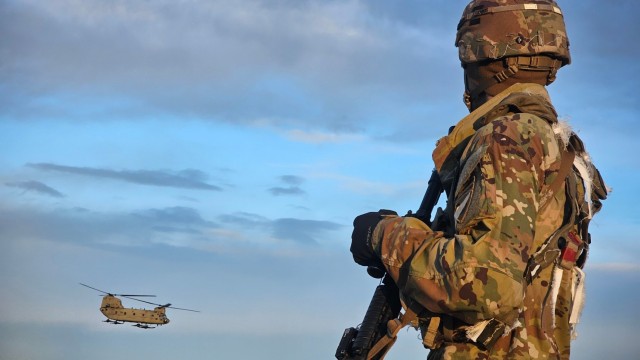U.S. Army Spc. Baily Rowe, a machine gunner assigned to 3rd Battalion, 509th Parachute Infantry Regiment, 2nd Infantry Brigade Combat Team (Airborne), 11th Airborne Division, gathers his parachute after conducting a joint forcible entry under the cover of darkness, kicking off Joint Pacific Multinational Readiness Center 25-02 onto Buffalo Drop Zone, in Donnelly Training Area, near Fort Greely, Alaska, Jan. 23, 2025. JPMRC 25-02, executed in Alaska with its world-class training facilities and its harsh Arctic environment, builds Soldiers and leaders into cohesive teams of skilled, tough, alert, and adaptive warriors capable of fighting and winning anywhere in the world.
(Photo Credit: U.S. Army photo by Spc. Elijah Campbell)
VIEW ORIGINAL
JPMRC is the U.S. Army’s newest combat training center, a coliseum of ice and snow where the division’s Soldiers train and fight against their fellow Arctic Soldiers, building the division’s warfighting capability in an Arctic environment and beyond.
The paratroopers wasted no time moving off the drop zone and seizing to their first objective, said 1st Lt. Joseph Watkins, a Battle Captain with 3rd Bn., 509th PIR.
“Our logistical support was executed well, being able to get ammunition, supplies, and gear to paratroopers is especially difficult in an austere, Arctic environment,” he added.
In addition to validating the 2nd IBCT’s readiness, JPMRC 25-02 was also a testament to the interoperability of the joint force and partner and Allied nations, including the U.S. Air Force, U.S. Marines, Canadian and Mongolian armies, and others from partner nations and across the U.S. Department of Defense.
As the temperatures continued to drop, the 2nd IBCT assembled defensive positions, engineered fortifications and patrolled through snowy-covered miles of fields and forests as the two Arctic elements continued their fight against the environment, and each other.

Pfc. Ian Alvarado, 725th Brigade Support Battalion, 2nd Infantry Brigade Combat Team (Airborne), 11th Airborne Division, watches as a Boeing CH-47 Chinook leaves the flightline after delivering gear, vehicles, and heavy equipment in support of Joint Pacific Multinational Readiness Center 25-02, Jan. 23, 2025, at Allen Army Airfield, Fort Greely, Alaska. The soldiers of the 11th Airborne Division are engaged in rigorous training at JPMRC 25-02 to enhance their lethality and readiness for large-scale combat operations in an Arctic environment. Our ability to dominate in this challenging terrain is critical to our mission success.
(Photo Credit: U.S. Army photo by Sgt. 1st Class Matt Kuzara)
VIEW ORIGINAL
“Whether it comes to a big, collective task or even the smallest, simplest one, it takes much longer to execute in the Arctic,” said Command Sgt. Maj. David Hanson, eenior enlisted leader of the 11th Airborne Division.
Across the exercise, the two forces met often, with flares illuminating the frosty battlefield, while orange and yellow muzzle flashes lit up the tree lines.
Paratroopers from 2-11 continued the fight and sustained it, despite temperatures below minus 30. It’s a skill set that the 11th Airborne Division and the JPMRC rotation in Alaska are uniquely able to provide to Soldiers and service members across partner nations and the joint force.
“We can’t just survive out here in the Arctic, we have to thrive,” Hanson said. “We are America’s only Arctic division and no one else is going to do it.”
Source link : http://www.bing.com/news/apiclick.aspx?ref=FexRss&aid=&tid=67b409d9fb234821bf8ff5b9374b30ff&url=https%3A%2F%2Fwww.army.mil%2Farticle%2F283096%2Fjpmrc_shapes_the_us_armys_only_arctic_division_for_the_frozen_battlefield&c=7243000819758304428&mkt=en-us
Author :
Publish date : 2025-02-17 13:28:00
Copyright for syndicated content belongs to the linked Source.












